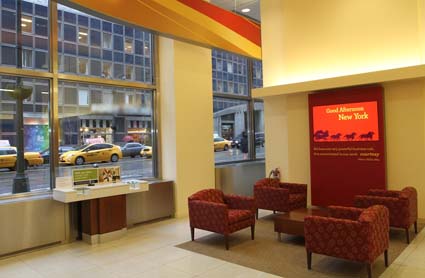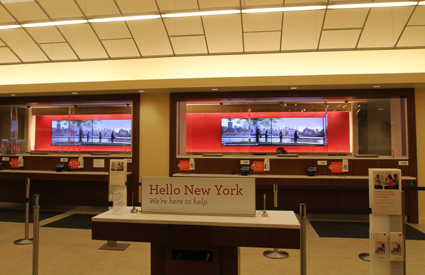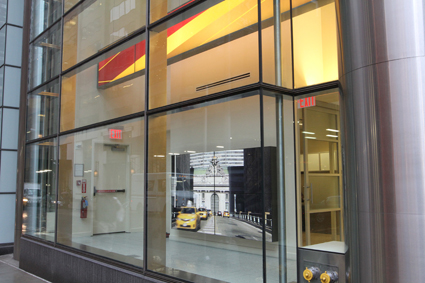Getting your bank started in digital signage
A basic blueprint from Wells Fargo’s digital leader
- |
- Written by Bob Killmeier

The forerunner to state-of-the-art digital signage in most financial institutions has been paper or vinyl signs--media that have been around for years. Vinyl has been affixed to many surfaces, from the front door and windows, to teller windows. Placards announcing brand information hang on walls. Marketing campaign panels are prominently displayed in a portable stand somewhere in the customer traffic lane.
Analysis of the effectiveness of signs and monitoring their relevance and freshness can be measured and controlled more easily if they are in a small number of branches. Managing almost 7,000 locations, such as at Wells Fargo, is fraught with issues.
What can digital signage offer that is different, better, and more effective than paper and vinyl signs? Quite a lot, we’ve discovered.
Full motion high-definition (“hi-def”) video content can attract customer attention. Monitors placed at entrances and exits present an ever-changing warm welcome or an appreciation for their business. You can begin by bringing branch visitors news, sports, weather, and stock indexes, in addition to presenting the bank’s brand message. Monitors also located at the check-writing counter can easily present cross-sell information, in addition to date and time. Lastly, monitors located behind the teller line and in the waiting area can allow the customer get some value out of any wait.
|
Places to get help with digital signage
|
||
OK, so now you’re thinking “We should go digital.” But how do you get things started at your bank?
A signage effort of any kind, but especially a digital effort, requires efforts from many quarters of the bank. This will give you an idea of what’s involved:
• Depending on the size of your bank, there may be many people you’ll need to confer with. In any institution, you’ll need to secure the buy-in to your project from many internal departments or functions. These may include: Senior Executive Management, Brand, Marketing, Legal, Compliance, Graphics (internal and/or external), Security, Information Technology, Network, Helpdesk support, and others. You’ll need to identify strategic and tactical goals as you may very well have to “sell” the merits of digital signage to secure others’ cooperation.
• Any digital launch should include a limited pilot, first in a “lab” environment, and then deployed to a few branches. Evaluation of results at each of these locations will permit the team to focus on various aspects of the tasks required to be successful in wide-scale deployment.
• Speaking of success, part of your planning is to clearly define goals to be achieved and the definition of what constitutes the successful end of the pilot.
• You should be able to project budget requirements for the lab and a limited pilot. Depending on your organization’s requirements you may need to provide a best guess as to the total cost to deploy over time.
• Seek unbiased research, which you can obtain from organizations such as www.DigitalSignageFederation.org
• Select software and hardware vendors who are willing to help in the lab setup.

The Wells Fargo branch at New York City’s Madison Avenue and 55th Street features a pair of teller wall digital signs, at this point displaying a cityscape. (Photo by Ted Swiet)
As with any kind of signage, the message is a key issue. Here are considerations you need to work out:
• The presentation should begin with story boards, mock ups of what customers would see, which graphically demonstrate features of digital signage indicating compliance with your bank’s brand guidelines and projection of the company’s message or messages.
• This is a good time to include technical issues that need to be addressed, but it’s critical to avoid drowning other bank functions in technical jargon. Many of the departments you need to secure buy-in from will tune you out if your message contains terms such as 1080p, LCD vs. LED vs. Plasma, HDMI, Hi-Def, and all the rest of the alphabet soup. Save the industry buzzwords until you have established a lab and can demonstrate various attributes.
• Your time will be better spent if you can show a mockup of a typical lobby indicating where the monitors will be deployed and what type of content will each play. This helps other players visualize what you have in mind.
• The time spent in garnering support and listening to ideas will be invaluable as you begin to build the lab environment. Remember, “Content is King” but it requires solid infrastructure and a proven software partner to insure that messages can be viewed as intended.
• Multiple budgets will provide the appropriate level of detail necessary to secure senior executive approval.
•Budgeting for the lab needs to include central application servers which are used to create content, store it, and deliver it to the appropriate player. Database servers are used to record and report player activity. Typically referred to as affidavits, content played at various times and different locations can measure effectiveness of marketing campaigns.
• The lab will need enough wall space, power outlets, network connections and room to move around. If possible it will be helpful if it has exterior facing windows so that appropriate design considerations can be made at an early stage of development process.
• This lab environment will be utilized as the DEV or Test location on a permanent basis. It is always desirable to let the graphic designers have a sandbox to enable testing of new scripts and hardware.
Now the project comes done to putting in actual live installations that the bank’s customers will see. Here is where what was learned in earlier phases gets put into effect.
• Budgeting branch installation will be based upon your experience in the lab plus local conditions.
• Depending on how geographically disbursed the branches are from your lab, you may experience several variables in logistics. Multiple A/V installation teams may be required, multiple cable companies may be needed, security access to sites after closing hours may require overtime and coordination with alarm procedures.
• At each site, you need to insure that detailed instructions are supplemented by an accountability installation checklist. The checklist should be used to record each team’s approval of completion of tasks assigned to them.
• Travel expenses may be required for the installation team. Airfare, hotel and meals and van rental are typical. If you are installing in a major urban location include a car service with a driver as during certain hours of the day parking is forbidden anywhere near your site.
• Preparing the players in advance and shipping to the installation integrator will yield a smother installation.
• Consider using software controls to control on/off monitors as many of the newest monitors have built in RS232 controls. Doing so may eliminate the need to provide external controllers and static IP addresses permitting more of a plug and play install.

Wells Fargo branch at New York City’s Lexington Avenue and 58th Street branch demonstrates that digital signage can be used to grab the eyes of passersby, not only to communicate in-branch. Here, the digital signage appears to mirror city life. (Photo by Ted Swiet)
This is where it all comes together and the bank begins to get the benefit. You’ve planned, secured approvals, budgeted, built a lab, and secured more approvals. While this has been going on, Marketing, Brand, and Legal Compliance have been working with Graphics to create Day 1 content and “story-boarding” for future content.
However, at this stage you will still be in learning mode. Day 1 content tends to be simpler than future content. It may or may not contain RSS (really simple syndication) feeds showing local news, weather, sports, and stock indexes. The objective is to receive feedback from customers and the bank’s team members so that changes are less expensive to implement prior to deployment to a wider number of sites.
The storyboarding of future content can contain automation of internal rates of CDs, home mortgages, and other loan types. The inclusion of rates adds a dimension of complexity to the content creation, as they have historically been used on paper being provided as handouts. (And as with everything that touches the consumer, information provided must pass muster with compliance requirements.)
Training of marketing managers in selecting the appropriate template is paramount as in large institutions as many as 60 individuals will have direct access to the system. This can grow dramatically if branch personnel are permitted to access the system as well. At Wells Fargo we have created training videos that are deployed using our peer-to-peer desktop network.
Finally, ensure you have combined the helpdesk functions of digital signage with other standard operating procedures common to the branch. All network-connected players should be able to report on their operational status. The best software will notify helpdesk personnel of any issues that require addressing. Branch personnel will be the only on-site “eyes and ears” source of how the monitors are behaving, and they will need a simple way to report any display issues to someone who can fix any problems.
 |
Killmeier has led the technology effort to provide on-demand desktop delivery to over 270,000 employees worldwide, in addition to assisting in the transition from analog video production to digital production.
In February 2011, he received the Excellence in Enterprise Video Award. He has accepted a position on the advocacy committee within the Digital Signage Federation.
Tagged under Management, Lines of Business, Technology, Community Banking,
Related items
- Wall Street Looks at Big Bank Earnings, but Regional Banks Tell the Story
- How Banks Can Unlock Their Full Potential
- JP Morgan Drops Almost 5% After Disappointing Wall Street
- Banks Compromise NetZero Goals with Livestock Financing
- OakNorth’s Pre-Tax Profits Increase by 23% While Expanding Its Offering to The US













